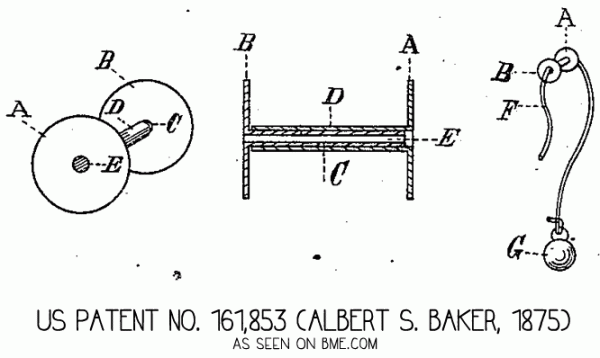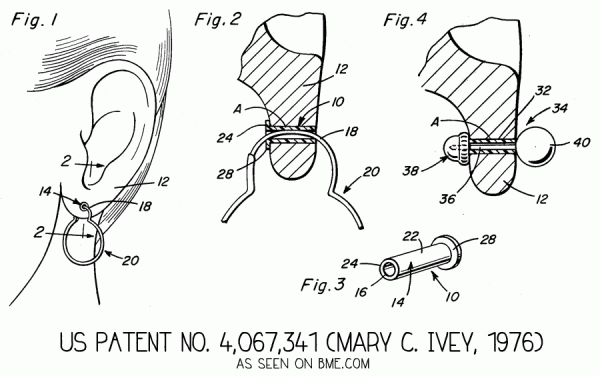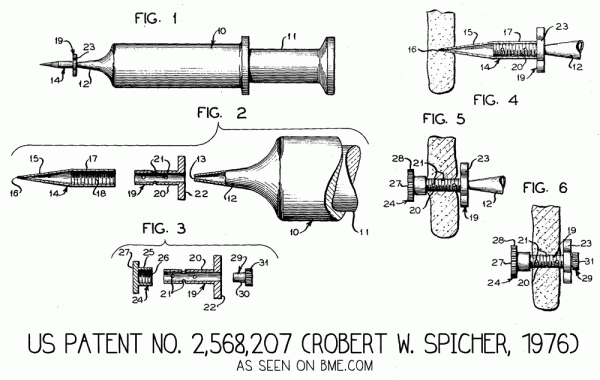I’ve sort of gotten hooked on reading these old patent records related to body modification, and just came across one that surprised me because of how ahead-of-its-time it was. In early 1875, Albert S. Baker of Somerville, MA filed a patent for what he called an “Imrpovement in Ear-rings” (US Patent #161,853). The patent is for a small gauge flanged tunnel to be worn in the earlobe — he explains,
“It is well known that in the use of ear-rings, as ordinarily constructed, the wires frequently tear out or cut the ear, and when not made of proper materials poison the parts with which they come in contact, thus sometimes causing great injury to the wearer. My invention is designed to obviate these difficulties and objections.”
He goes on to describe the device (which he calls a “spool” at times), which he instructs should be made of high quality gold, thus eliminating materials reactions such as nickel allergies. In addition, because the device is larger gauge than the fine wire that often makes up the hook of an earring, it reduces the chance of the jewelry pulling through. What, you thought Todd Bertrang was the first person to tell the world these things? Still, I was pleasantly surprised to see these concepts tossed around in detail nearly 140 years ago.
Many later jewelry designs also presented similar ideas (his appears to be the first hollow tunnel that was patented), but I will just very briefly mention another one of them, a patent filed in 1976 by Mary C. Ivey of Atlanta, GA (US Patent #4,067,341). Her concept is almost identical, and she explains it very similarly in her application, but adds that her design both allows the secondary jewelry more freedom to move due to the tunnel being larger, and also suggests taking advantage of advances that have been made in materials sciences (specifically plastics) to improve the design. Unfortunately she’s vague on many aspects (as is frustratingly common in patents) and does not however come out and say the actual diameter of the tunnel — as pictured I’m guessing in the realm of 8ga.
As you can see in those illustrations, the visual effect of someone wearing these tunnels — or “pierced earlobe protector” as Ms. Ivey titles it — is very, very close to someone wearing a small gauge tunnel of the sort we see all the time walking out the doors of your friendly neighborhood piercing studio. The one thing that neither Ivey nor Baker mention in their patents how the piercing is to be done, which I’m curious about, especially with Ivey’s, which seems to be getting too big to just shove into your average hole*. The only such insertion-method explanation I stumbled across regarding this style of jewelry was one filed in 1949 by Robert W. Spicher of Havre, MT (US Patent #2,568,207) for a “Surgical Piercing Device”.
The jewelry itself is superficially similar in design and intent to the others in this entry, but it also includes a sharpened taper that can be tightly fitted over the tunnel, either creating the new piercing hole or squeezing into an existing one, and then expanding that hole. The particularly creative part is that he then uses a syringe to blow air into the tunnel to make the taper pop off like a champagne cork — hopefully not shooting like a tiny bullet into the wearer’s neck! — to be replaced with a cap that keeps the tunnel from falling out.
______
* “that’s what she said”



 BME/News and Modblog highlight only a small fraction of what
BME/News and Modblog highlight only a small fraction of what
Thats just amazing =) I love reading your articles they are so interesting =)
Thats just amazing =) I love reading your articles they are so interesting =)
Thats just amazing =) I love reading your articles they are so interesting =)
Thats just amazing =) I love reading your articles they are so interesting =)
hahhah I love that you made a that’s what she said joke.
hahhah I love that you made a that’s what she said joke.
hahhah I love that you made a that’s what she said joke.
hahhah I love that you made a that’s what she said joke.
I’m pretending it’s 2005.
I’m pretending it’s 2005.
I’m pretending it’s 2005.
I’m pretending it’s 2005.
are these tiny holes in the tunnel from the “Surgical Piercing Device”?
are these tiny holes in the tunnel from the “Surgical Piercing Device”?
are these tiny holes in the tunnel from the “Surgical Piercing Device”?
are these tiny holes in the tunnel from the “Surgical Piercing Device”?
Is there a claim that Todd was the first person to introduce the thought that large gauge jewelry would prevent migration/cutting/tearing over time? I know it was a big thing for him, but have never heard he was the first to say so. If so I’d like to read more if available.
Is there a claim that Todd was the first person to introduce the thought that large gauge jewelry would prevent migration/cutting/tearing over time? I know it was a big thing for him, but have never heard he was the first to say so. If so I’d like to read more if available.
Is there a claim that Todd was the first person to introduce the thought that large gauge jewelry would prevent migration/cutting/tearing over time? I know it was a big thing for him, but have never heard he was the first to say so. If so I’d like to read more if available.
Is there a claim that Todd was the first person to introduce the thought that large gauge jewelry would prevent migration/cutting/tearing over time? I know it was a big thing for him, but have never heard he was the first to say so. If so I’d like to read more if available.
Tobias – No, there’s no such claim… It was just a joke. But he definitely was a very early and dedicated proponent of the idea and deserves much credit for it.
Tobias – No, there’s no such claim… It was just a joke. But he definitely was a very early and dedicated proponent of the idea and deserves much credit for it.
Tobias – No, there’s no such claim… It was just a joke. But he definitely was a very early and dedicated proponent of the idea and deserves much credit for it.
Tobias – No, there’s no such claim… It was just a joke. But he definitely was a very early and dedicated proponent of the idea and deserves much credit for it.